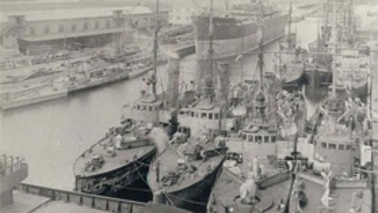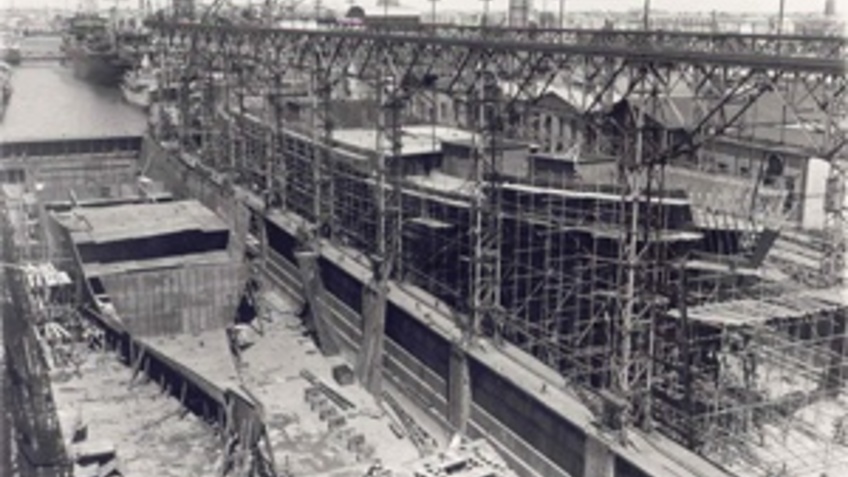
SSW Shipyard
Born in Brake halfway between Bremen and Bremerhaven, the coppersmith Georg Dietrich Seebeck (1845-1928) settled down in Geestemünde in 1871. In 1876, he started his own firm. At a small forge he was soon manufacturing boats and launches. In 1886, Seebeck purchased a site situated on a narrow channel in the Geestemünde port area, which enabled further expansion. In 1891 and 1895, he acquired the Geestemünde and Bremerhaven yards of Schau & Oltmanns, Lange and Ulrichs and used their sites and equipment. In 1895, the firm was transformed into a shareholding company to mobilize more necessary capital.
Because of the different acquired shipyards along the River Geeste, Seebeck operated his business on very scattered sites. So he had a new shipyard constructed in the Geestemünde Handelshafen basin from 1906 to 1910. The main shipbuilding activities were moved to that new area. The manufacturing of ships in docks (and not, as commonplace, on slipways) was indeed a very progressive method.
The main output consisted of smaller vessels such as launches and tugs. In 1891, the first Seebeck-built steam trawler was delivered. This type of ship was manufactured in large numbers and gained importance for the business of Seebeck as a whole, forming also the image of the company. But cargo steamers, smaller passenger vessels and some types of special purpose vessels were also built. In 1914, more than 1000 employees worked on the yard.
In the First World War, military production for the Imperial German Navy became important, after 1918, production for non-military customers was resumed. Fishing trawlers (in the thirties also a number of whale catchers), tugs and cargo vessels still made up the main share of production. In the 1920s and 1930s however, the shipyard suffered from the economical slump, and in 1928, Seebeck was integrated into the mighty Deschimag shipbuilding combine.
Having produced for the navy in World War II, the yard went into partnership with the prominent AG “Weser” shipyard in Bremen until 1984. The Bremerhaven yard was modernized and now they also built larger vessels such as deep-sea cargo ships, Ro-Ro-Ferries, research and passenger ships. In 1988, the Seebeck yard merged with the Bremerhaven-based Schichau-Unterweser yard to become the Schichau Seebeckwerft AG.
This process was and still is typical for the general development in German shipbuilding industries, because the competition, mainly from East Asian yards, has become more and more fierce, causing a decline of capacity.
The historical roots of the Schichau-Unterweser yard which joined with Seebeck are also worth looking at. The engineer Ferdinand Schichau (1814-1896) founded a small machinery workshop in the West Prussian town of Elbing (today Elblag, Poland) in 1837. In 1855, the construction of iron ships was started. World fame was gained by special purpose vessels such as the legendary torpedo boats, but also by dredgers and a wide range of naval and mercantile types, both for German customers and abroad. In 1891, another yard was opened at Danzig (today Gdansk, Poland). Larger ships were built there, also for the North German Lloyd of Bremen. The Polish yard which worked later on the same site made history subsequently when the independent trade union Solidarnosc was founded there.
Having moved west in 1945, the Schichau yard continued in Bremerhaven, now concentrating mainly on the construction of tugs. In 1972, the yard joined the Unterweser yard, the roots of that firm dating back to 1903. It was situated on the Geeste River. So the Schichau-Unterweser shipyard was formed, which then merged with the Seebeck firm only 16 years later. The main shipbuilding activities were now centred on the modernised Seebeck area.
Since 1st of May 1998, the company has been known as SSW Fähr- und Spezialschiffbau GmbH. It went into receivership in 2002, but the yard was finally able to continue operation. Facing stiff international competition, the firm still builds ferries, but also acts as subcontractor for other shipyards.


